Valdez
Above 4,000ftConsiderable
2,000 to 4,000ftConsiderable
Below 2,000ftModerate
Degrees of Avalanche Danger
Avalanche Problems
Problem 1
The latest storm from 2/28-3/1 produced 2-6 inches of snow and strong winds that switched direction from south to north as the storm progressed. North winds are forecasted to gain strength through the day and may reach speeds of 75 mph through Thompson Pass Friday night.
There is currently a limited amount of snow available for transport (2-6 inches) in areas where wind speeds are less than 50 mph. This is due to previous wind events from the last 10 days that have left wind damaged surfaces in most locations along the road corridor prior to the latest storm. This will limit the depth of wind slabs developing up to around 1 foot deep, although deeper pockets are possible in isolated locations. Expect for wind slabs to be initially sensitive to human triggers while they are still soft (4 finger- 1 finger). As wind slabs stiffen over time expect for the sensitivity to decrease, although avalanches that do occur would be able to propagate wider. As wind speeds become stronger than previous events (> 50 mph) expect for more snow to be available for transport as stronger winds are able to break down old wind damaged snow.
Expect to find wind slabs that are reactive to human triggers on the lee side of terrain features, ridge lines (SE-NW) and in cross loaded gullies. Use test slopes to determine the depth and sensitivity of wind slabs in the area you choose to travel. Shooting cracks, collapsing and natural avalanche activity are all signs of unstable snow at the surface that is capable of producing avalanches.
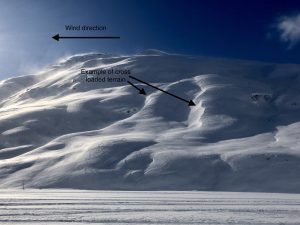
Likelihood:
- Almost Certain
- Very Likely
- Likely
- Possible
- Unlikely
Size:
- Historic
- Very Large
- Large
- Small
Trend
- Increasing
- Steady
- Decreasing
Problem 2
An abnormal amount of Cornice falls have been reported last week that triggered very large avalanches (D2-D3). Cornices have been observed and reported as being larger than normal and poorly attached. Cracks on ridge tops showing cornices separating from ridge lines have been observed and reported. Cornices will continue to grow in size with strong winds.
Cornices are an objective mountain hazard that should always be a concern. Although, recent activity strongly shows that we need to keep an extra cautious approach to avoiding overhead exposure to cornices. Avoid traveling below or on top of cornices. The avalanches that cornice fall has recently produced are unsurvivable events.

Likelihood:
- Almost Certain
- Very Likely
- Likely
- Possible
- Unlikely
Size:
- Historic
- Very Large
- Large
- Small
Trend
- Increasing
- Steady
- Decreasing
Problem 3
There are currently 3 persistent weak layers that exist in our mid-upper snowpack that are worth noting. 2 of these are unlikely to be affected by human triggers at this point. The layer closest to the surface and still a potential concern is the 2/23 buried surface hoar layer. Prior to the latest wind event this layer only existed in specific locations in our forecast area (wind sheltered mid elevations). This layer is becoming less likely to be encountered as it has been destroyed by wind in most areas. It may be possible that this layer still exists underneath old wind slabs created 2/25-27 on SE-NW aspects.
Other persistent layers of concern include the 1/14 buried surface hoar which is likely the responsible failure plane of some very large recent avalanches triggered by cornice fall. Human triggered avalanches at this layer are currently unlikely due to their depth (80-150 cms). But if they were to occur, would likely be in areas where a thinner snowpack exists and this layer is still relatively close to the surface (less than 3 feet).
The last layer we are tracking in the mid- upper snowpack is the 1/25 rain crust/ facet combo. This layer exists below 2500′. Collapsing in the Intermountain and Continental zone has been observed at low elevations failing at this layer. Natural and human triggered avalanches have not been reported at this layer and stability tests continue to show a lack of results and rough shears. Even though human triggered avalanches are unlikely at this layer, it is still worth investigating if choosing to travel in steep consequential terrain at low elevations.
Likelihood:
- Almost Certain
- Very Likely
- Likely
- Possible
- Unlikely
Size:
- Historic
- Very Large
- Large
- Small
Trend
- Increasing
- Steady
- Decreasing
Problem 4
Weak snow created by early season cold temps, dry conditions and strong north winds have showed poor structure near the base of the snowpack. This weak snow has been dormant through the majority of the season with human triggered avalanches being unlikely at this layer. As the sun has come out last week several very large natural avalanches have occurred with cornice and ice falls being the triggers. Human triggers remain unlikely at this layer, although these events show that large triggers can affect this weak snow. Cornice fall will be the most likely trigger to affect this weak snow, although it is possible that a large group could have the same affect. Avoid overhead exposure to cornices.
In most location facets near the ground have been found to be rounding and unreactive in stability tests. In thin areas of the snowpack basal facets have been found to be more developed. If you find it is possible to push a ski pole to the ground in areas you travel, assume that a weak faceted snowpack exists in that location. These areas could act as a trigger point.
Likelihood:
- Almost Certain
- Very Likely
- Likely
- Possible
- Unlikely
Size:
- Historic
- Very Large
- Large
- Small
Trend
- Increasing
- Steady
- Decreasing
Avalanche Activity
Below is a summary of observed Avalanche activity from the last 7 days. Avalanches that were noted earlier in the season can be viewed by clicking the link below.
If you trigger or observe an avalanche consider leaving a public observation.
2/24- Natural D2.5 wind slab avalanche that failed on 2/23 BSH in the Tsaina Valley / S-SE aspect ~6000’/ ran ~3500 vertical (full track)/ crown ~1 foot deep and ~2000′ wide. SS-N-R4-D2.5
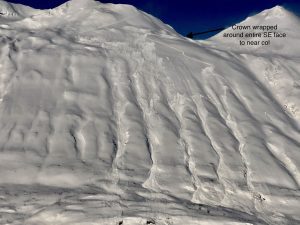
2/22- Natural D 2.5 cornice fall avalanche was reported on a NW aspect/ ~6000 in the books. 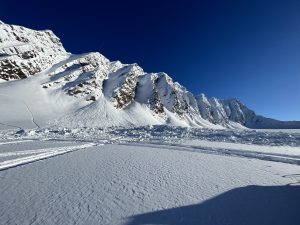
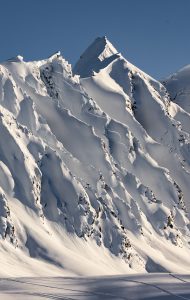
2/20- Numerous D1-D2 natural and human triggered avalanches were observed and reported up to 1 foot in depth on a variety of aspects. These occurred in areas where fresh wind slabs were present.
– D3 natural avalanche observed on Snoopys (Port of Valdez). NW aspect/ ~5000’/ ran ~3500 vertical feet with a track length of approximately 1 mile mapped on Google Earth. This was a hard slab avalanche the failed at weak layer in the mid snowpack. HS-N-R4 D3. No other avalanches of this size have been observed or reported in our forecast area.
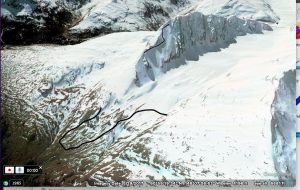
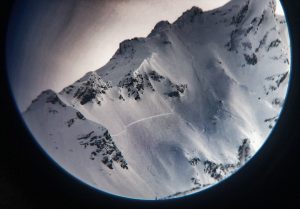
Weather
Check out our updated weather tab! A collection of local weather stations are available for viewing with graphs and tabular data included.
NWS Watches and warnings
...HIGH WIND WATCH REMAINS IN EFFECT FROM THIS EVENING THROUGH SATURDAY MORNING... * WHAT...Northeast winds 40 to 50 mph are expected with gusts up to 75 mph possible. * WHERE...Valdez through Thompson Pass. * WHEN...From Friday evening through late Saturday morning. * IMPACTS...High winds could move loose debris, damage property, and cause power outages. Travel could be difficult, especially for high profile vehicles. * ADDITIONAL DETAILS...Some uncertainty exists with the extent of cold air moving into Northeast Prince William Sound, which is a potential limiting factor for gusts hitting 75 mph. However there is above average confidence that wind gusts of 60 to 70 mph will develop later tonight and continue through the morning hours on Saturday. Transportable snow may also still be present at the time of these higher winds, so visibilities may be reduced in areas of drifting or blowing snow.
NWS Point forecast for Thompson Pass
Date Friday 03/03/23 Saturday 03/04/23 Time (LT) 06 12 18 00 06 12 18 00 06 Cloud Cover OV OV BK SC FW CL FW FW FW Cloud Cover (%) 80 80 60 30 5 5 10 10 15 Temperature 7 12 10 1 -3 3 4 1 2 Max/Min Temp 14 -3 6 0 Wind Dir N N N NE NE NE NE NE N Wind (mph) 26 28 32 32 33 29 25 20 23 Wind Gust (mph) 39 40 48 56 63 56 39 Precip Prob (%) 5 5 0 0 0 0 0 0 0 Precip Type 12 Hour QPF 0.00 0.00 0.00 0.00 12 Hour Snow 0.0 0.0 0.0 0.0 Snow Level (kft) 0.0 0.0 0.0 0.0 0.0 0.0 0.0 0.0 0.0
Click on link below for Thompson Pass weather history graph:

| Date:
03/03 |
24 hr snow | HN24W* | High temp | Low temp | 72 hour SWE* | March snowfall | Seasonal snowfall | Snowpack Depth |
| Valdez | 0 | 0 | 32 | 27 | .1 | 2 | 218 | 62 |
| Thompson pass | 0 | 0 | 17 | 12 | N/O | 5 | 373 | N/O |
| 46 mile | 0 | 0 | 25 | 16 | 0 | 0 | ~85** | 42 |
*HN24W- 24 hour Snow water equivalent in inches
*SWE– Snow water equivalent
**46 mile seasonal snowfall total begins December 1st.
Additional Information
Click on the link below for a running summary of the seasons weather history.
Announcements
The avalanche hazard is Considerable above 2000 feet and moderate below. Human triggered avalanches are likely in specific areas. Natural avalanches are possible. Strong winds are redistributing 2-6 inches of storm snow from 2/28-3/1 into fresh wind slabs. These will be reactive to human triggers on lee aspects up to 1 foot in depth. Watch for signs of instability including shooting cracks, collapsing and recent avalanche activity.
Posted by Gareth Brown 03/03 8:00 am.
For a description of current avalanche problems, weather information, season history and more click the (+ full forecast) button. Avalanche forecasts will be issued Wednesday-Sunday.
If you have pictures of recent natural or human triggered avalanches or notice signs of instability such as shooting cracks or collapsing, leave an observation to help improve forecast accuracy.



